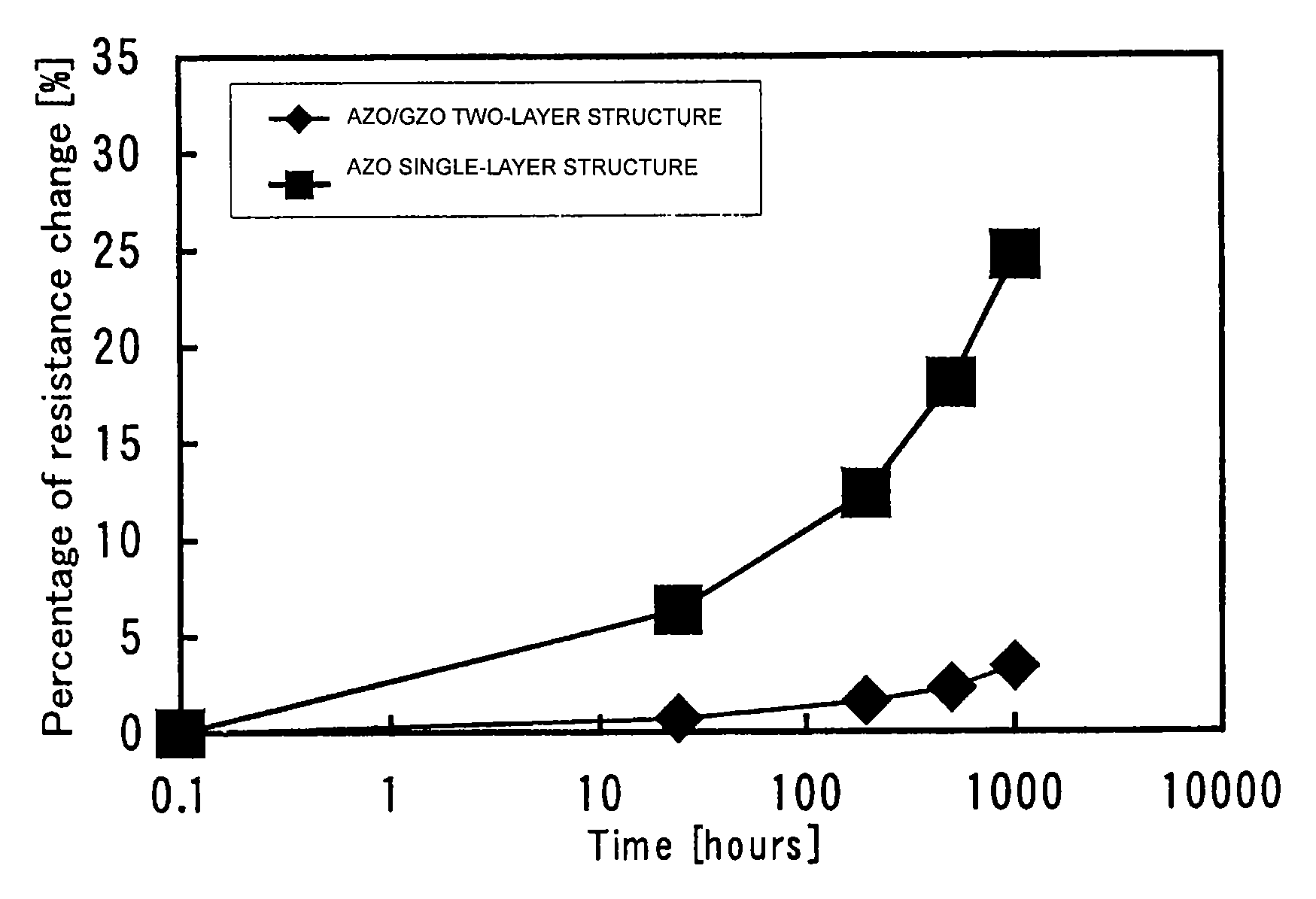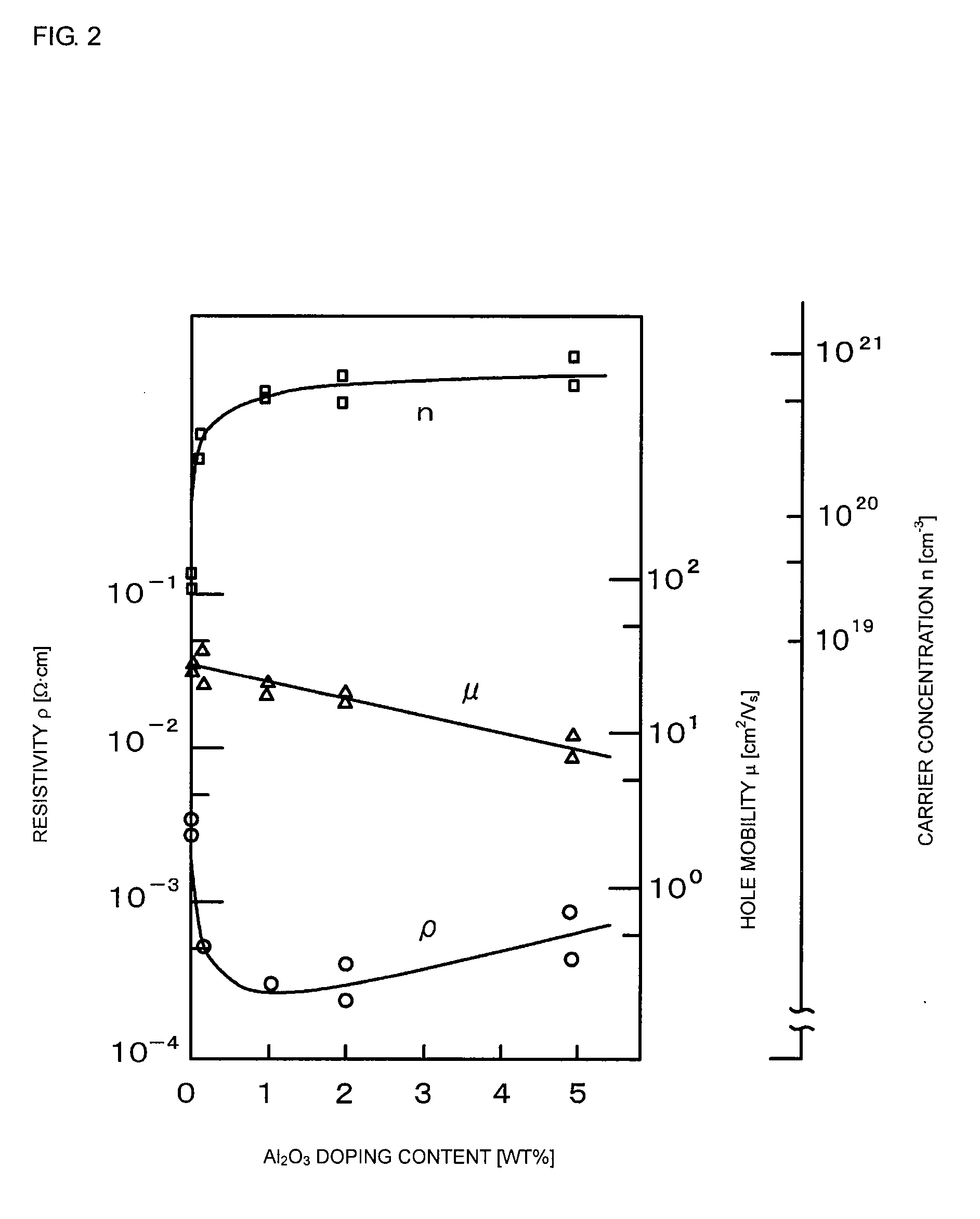Conductive film and method for manufacturing the same
- Summary
- Abstract
- Description
- Claims
- Application Information
AI Technical Summary
Benefits of technology
Problems solved by technology
Method used
Image
Examples
example 1
[0087]FIG. 6 is a view of a conductive film formed on a substrate according to an example (EXAMPLE 1) of the present invention.
[0088]As shown in FIG. 6, a conductive film 10 of EXAMPLE 1 has a two-layer structure composed of a first ZnO conductive film layer 1 being transparent, formed on a surface of a substrate 11, and including ZnO as a main component and a Group III oxide as a dopant and a second ZnO conductive film layer 2 being transparent, formed on the first ZnO conductive film layer 1, and including a Group III oxide as a dopant different to the Group III oxide included in the first conductive film layer.
[0089]Note that, in EXAMPLE 1, a glass substrate made of alkali-free glass (Corning 1737) was used for the substrate 11.
[0090]A ZnO conductive film was formed on a surface of the glass substrate 11 as the first ZnO conductive film layer 1 doped with Ga2O3 as a Group III oxide.
[0091]Furthermore, another ZnO conductive film was formed on the first ZnO conductive film layer 1 ...
example 2
[0113]EXAMPLE 1 describes a case where a glass plate is used as a substrate on which a conductive film is formed. EXAMPLE 2 describes another case where a PEN (polyethylene naphthalate) flexible substrate is used as a substrate on which a conductive film is formed. By a method similar to those used in the above-mentioned EXAMPLE 1, PEN substrates were subjected to a preparation treatment and sputtered under the same conditions as those performed in EXAMPLE 1. An AZO / GZO two-layer structure conductive film and an AZO single-layer structure conductive film were formed on the flexible substrates composed of PEN.
[0114]Properties of each conductive film were investigated using a method similar to those used in the above-mentioned EXAMPLE 1. Measurement results similar to those obtained from EXAMPLE 1 were obtained. It was found that if the conductive film is formed on a flexible substrate composed of PEN, a ZnO conductive film constituted by an AZO / GZO two-layer structure film has high c...
example 3
[0115]EXAMPLE 1 describes a case where a glass plate is used as a substrate on which a conductive film is formed and EXAMPLE 2 describes a case where a PEN flexible substrate is used as a substrate on which a conductive film is formed. EXAMPLE 3 describes another case where a PET (polyethylene terephthalate) flexible substrate is used as a substrate on which a conductive film is formed. By a method similar to those used in the above-mentioned EXAMPLES 1 and 2, PET substrates were subjected to a preparation treatment and sputtered under the same conditions as those performed in EXAMPLE 1. An AZO / GZO two-layer structure conductive film and an AZO single-layer structure conductive film were formed on the flexible substrates composed of PET.
[0116]In EXAMPLE 3, similarly to EXAMPLES 1 and 2, when a flexible substrate composed of PET (polyethylene terephthalate) was used as a substrate, it was found that a ZnO conductive film constituted by an AZO / GZO two-layer structure film has high cry...
PUM
| Property | Measurement | Unit |
|---|---|---|
| Thickness | aaaaa | aaaaa |
| Concentration | aaaaa | aaaaa |
| Electrical resistance | aaaaa | aaaaa |
Abstract
Description
Claims
Application Information
 Login to View More
Login to View More - R&D
- Intellectual Property
- Life Sciences
- Materials
- Tech Scout
- Unparalleled Data Quality
- Higher Quality Content
- 60% Fewer Hallucinations
Browse by: Latest US Patents, China's latest patents, Technical Efficacy Thesaurus, Application Domain, Technology Topic, Popular Technical Reports.
© 2025 PatSnap. All rights reserved.Legal|Privacy policy|Modern Slavery Act Transparency Statement|Sitemap|About US| Contact US: help@patsnap.com



